I have created a Myspace page called CricketFanatic where you can join up and help promote the game of cricket amongst the social networking communities as well as promoting this site at the same time. Feel free to check it out by right-clicking HERE.
If you don't have a Myspace account don't stress, as you can click on the "HERE" link above and do it from there also.
Hope you enjoy your visit :).
Monday, December 29, 2008
Cricket Fanatic(s) on Myspace.com
Player Profile(#43)...Dale Steyn (South Africa)

Dale Willem Steyn (born 27 June 1983 in Phalaborwa) is a South African cricketer who plays in Test and One Day International cricket for South Africa. Steyn plays domestic cricket in South Africa for Nashua Titans. He is a right-arm fast bowler. Steyn holds the record for the fastest South African to reach 100 wickets in Test Match cricket, a feat he achieved on 2 March 2008 . Steyn currently has the second best bowling strike rate of all time in Test match cricket (amongst bowlers who have bowled a significant number of deliveries), behind George Lohmann . He achieved a tally of 78 wickets at the world class average of 16.24 in Season 2007/08 and was subsequently rewarded with the prestigious ICC 2008 Test Cricketer of the Year Award. He also plays foor the Bangalore Royal Challengers in the Indian Premier League (IPL).
Playing style:
Steyn is an aggressive out-and-out fast bowler capable of bowling at speeds in excess of 145 km/h. He is capable of generating considerable swing and usually chosen to bowl with the new ball to maximise these attributes . Steyn is an extremely competitive cricketer and often celebrates vigorously after taking a wicket. He has stated that "(he) love(s) the buzz from bowling fast" and that "(he) want(s) to be the quickest in the world".
Although he has the ability to hit the ball hard, Steyn is usually considered a tail-ender when batting and often bats at number ten or eleven.
International career:
Home Tests against England 2004/05:
Steyn made his debut for South Africa on 17 December 2004 in the first Test of England's tour. His first victim in Test cricket was Marcus Trescothick whom he bowled with a fast in-swinging delivery. However, his overall performance was underwhelming, he took eight wickets at an average of 52.00, and he was dropped after bowling poorly in England's second innings of the fourth Test in January 2005, bowling eight no balls in nine overs which went for 47 runs. England won the match by 77 runs.
One Day Internationals 2005/06:
Later that year, Steyn was picked in the squad for the African XI in the Afro-Asia Cup of 2005/06, and he made his One Day International debut on 17 August 2005. The African XI won the match, with Steyn bowling last batsman Ashish Nehra to seal victory by two runs. Steyn made his One Day International debut for South Africa on 20 January 2006 in a match against Australia at Melbourne, a match which was part of the 2005-06 VB Series. Steyn did not bowl particularly well and after another below par performance against Sri Lanka he dropped out of consideration for the South African ODI team.
Home Tests against New Zealand 2005/2006:
Following a strong season playing domestic cricket for the Titans, Steyn was recalled to the Test side to play New Zealand in April 2006. He responded to his opportunity with his first five-wicket haul in the first Test at Centurion, ripping through the New Zealand batting lineup along with Makhaya Ntini as New Zealand crumbled to 120 all out, chasing 248 to win . He finished the three Test series with 16 wickets at 26.00 and made a fine impression throughout.
Away Tests against Sri Lanka 2006:
Steyn was included in the Test team to play Sri Lanka away in a two match series in July and August 2006. In his first overseas Test, at the Sinhalese Sports Club Ground, Colombo, he took 3 for 129 as Sri Lanka piled up 756-5, with Kumar Sangakkara and Mahela Jayawardena putting together the highest Test match partnership ever (624 runs). South Africa slumped to defeat by an innings and 153 runs . In the second Test, at the Paikiasothy Saravanamuttu Stadium, Colombo, Steyn took his second five-wicket haul in Tests during Sri Lanka's first innings, but went wicketless in their seconds innings as Sri Lanka sealed a 2-0 series victory by a single wicket. Steyn finished the series with eight wickets at an average of 36.50.
Home Tests against India 2006/07:
Steyn retained his Test place for the three match home series against India. He picked up an injury whilst bowling early in India's first innings in the first Test at Johannesburg which prevented him from taking much further part in the game and also ruled him out of the second Test. He returned to play in the deciding third Test at Cape Town and bowled well, taking six wickets for 88 runs in the match as South Africa clinched the match and the series. He finished the series with six wickets at an average of 19.00.
Home Tests against Pakistan 2006/07:
Despite his strong performance on his return to the team in the third Test against India, Steyn missed out on a place in the first two Tests against Pakistan, with the selectors opting to play a four man attack featuring full-time spinner Paul Harris. He returned in the third Test, at Cape Town, when the selectors decided to rest Andre Nel and Shaun Pollock in preparation for the immanent 2007 Cricket World Cup. He took four wickets in the match for 87 runs as South Africa won the match by 5 wickets and took the series 2-1. As this was his only match, his average for the series was 21.75.
One Day Internationals 2007:
Steyn was recalled to the South African ODI squad in June 2007 and played in three matches between June and August, against Ireland, India and Zimbabwe. He had mixed success in these three matches, taking wickets but proving expensive.
Away Tests against Pakistan 2007/2008:
Steyn was picked for the Test squad to tour Pakistan in October, and played in both Tests. In the first Test at Karachi, during Pakistan's second innings, he picked up his third Test five-wicket haul as Pakistan were bowled out for 263 chasing 424 to win. He had an unremarkable second Test, with the match petering out to a draw, handing South Africa the series 1-0, and finished the series with nine wickets at 24.66.
Home Tests, ODIs and T20 against New Zealand 2007/2008:
Steyn was by now an established member of the Test team, and he produced his finest series performance to date in the two Test matches against New Zealand in November. In the first Test at Johannesburg he collected his fourth and fifth five-wicket hauls (5/35 and 5/59) and his first ten-wicket match as New Zealand were thrashed by 358 runs, South Africa's biggest victory margin in terms of runs to date. Steyn was also awarded his first Test Man-of-the-Match award. This devastating form continued into the second Test at Centurion where he picked up 4/42 in the first innings and his sixth five-wicket haul (6/49) to help South Africa to victory by an innings and 59 runs. His second ten-wicket match earnt him his second Man-of-the-Match award in a row and his series performance of 20 wickets at an average of 9.20 won him his first Man-of-the-Series award. On the back of his performance, he broke into the top five of the ICC rankings for Test bowlers for the first time in his career.
He made his Twenty20 International debut on 23 November 2007 in the one-off game against New Zealand, taking the wicket of Scott Styris and only giving up 17 runs from his four overs. He also featured in the third One Day International at Cape Town, where he had partial success, taking the wickets of the New Zealand openers, Brendon McCullum and Lou Vincent, but going for 50 runs from nine overs.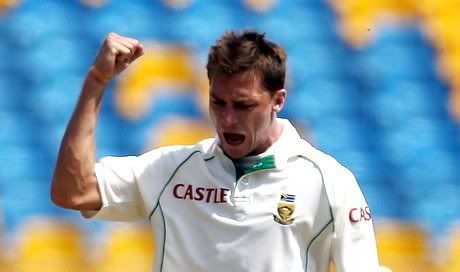
Home Tests, ODIs and T20 against West Indies 2007/2008:
Steyn's next international appearance was in the first Twenty20 International against the West Indies. He took the exceptional figures of 4/9 in three overs, with all four wickets being picture perfect yorkers, but was unable to stop the West Indies chasing down the target of 59 runs.
Steyn's form continued into the Test series. He had a fairly indifferent match in the first Test at Port Elizabeth, taking 5/188 in the match as the West Indies scored their first away victory in Test matches for two and a half years, although he did hit his highest Test match score to date, 33 not out, in South Africa's second innings. He picked up figures of 4/60 and 4/44 in the second Test at Cape Town as South Africa leveled the series and once again proved his worth in the deciding third Test at Durban by taking 1/18 and 6/72, his seventh five-wicket haul, as the West Indies were thrashed by an innings and 100 runs. His 20 wickets at 19.10 earnt him his second consecutive Man-of-the-Series award.
He played in the first three matches of the One Day International series, but couldn't match his Test success and was briefly dropped after failing to take a wicket and going for 62 runs in his ten overs during the third match at Port Elizabeth. He was recalled for the fifth match at Johannesburg but struggled again, taking one wicket but going for 78 runs from ten overs.
Away Tests and ODIs against Bangladesh 2007/08:
In the first Test of the two match series against Bangladesh, at Dhaka, Steyn helped South Africa avoid an embarrassing defeat. Bangladesh were bowled out for 192 in their first innings, with Steyn claiming 3/27, but then South Africa collapsed to 170 all out, handing the hosts a shock 22 run lead. However Steyn (4/48) then combined with Jacques Kallis (5/30) to restrict Bangladesh to 182 all out and South Africa were able to complete a five wicket victory on the fourth day of the match. South Africa won the second Test at Chittagong comprehensively (by an innings and 205 runs) and Steyn returned figures of 4/66 and 3/35 giving him 14 wickets in the series at an average of 12.57, which won him his third consecutive Man-of-the-Series award. When Steyn dismissed Junaid Siddique in Bangladesh's first innings (his 20th match), he claimed the record for the fastest South African to reach 100 wickets in Tests, beating Hugh Tayfield's record of 21 matches. He holds the record amongst all players who are currently playing Test cricket. Steyn featured in the final One Day International of the three match series, going wicketless but only giving away 19 runs in 8 overs.
Away Tests against India 2007/08:
Coming into the three Test series against India predictions about how Steyn would fare were mixed, with some commentators identifying him a crucial part of a South African team which could pose a serious challenge to India, whilst others predicted he might struggle playing against a strong batting lineup on lifeless subcontinent pitches.
The first Test at Chennai turned out to be a very high scoring affair, with South Africa batting first and making 540, then India responding strongly, led by Virender Sehwag who scored 319 from 304 balls, to reach 468/1 by the end of the third day. On the fourth day Steyn helped to restrict India's lead to 87 runs by dismissing MS Dhoni with a bouncer then blasting through the lower order, taking three wickets in two overs for the cost of two runs, all bowled with reverse swinging deliveries. He finished the innings, and the match which petered out into a tame draw, with four wickets for 103 runs. On the morning of the second Test at Ahmedabad, South Africa demolished the much vaunted Indian batting line within twenty overs, for the meagre total of 76 runs. Steyn was the pick of the bowlers taking five wickets for 23 runs, dismissing Sehwag and Rahul Dravid then mopping up the last three batsmen for the cost of 11 runs. In the second innings he added a further three wickets to his match tally, finishing the game with eight wickets for 114 runs, as South Africa completed a crushing victory by an innings and 90 runs. The final Test at Kanpur saw Steyn pick up three first innings wickets which took him to 15 wickets in the series at 20.20. As a result of this, the cumulation of an outstanding 2007/08 season in which he took 75 wickets in 11 matches, Steyn moved up to joint first place (alongside Muttiah Muralitharan) in the ICC Test match bowling rankings.
Away Tests against Australia 2008/2009:
In the 2nd test match in a 3 match series, Steyn was involved in a record 10th wicket partnership of 180 with J.P. Duminy. Steyn recorded a score of 76 (191 deliveries) in an innings that helped South Africa recover from 6-141 to post a score of 459. Steyn also starred in the first innings with figures of 5-87 (29.0 overs).
Links to more information on Dale Steyn:
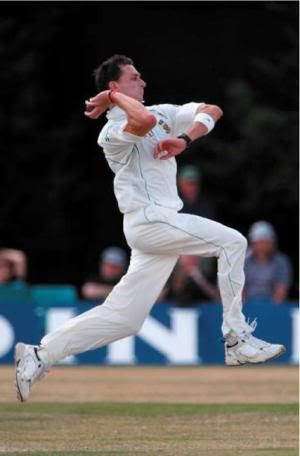
*Acknowledgements to Wikipedia.org and owners of pictures and videos used.

We Love Cricket! A cricket community on Facebook.com
I have created a group on Facebook for anyone and everyone who is interested in Cricket. All are welcome to join as long as you don't post spam etc on the boards and the wall. You might be prompted to login to your Facebook profile/page before you can view it, if you don't have a Facebook profile/page you can sign up using the sign-up link.
I am looking at boosting numbers in this community so there can be a high level of visitor interaction and lots of interesting cricket related posts on the wall etc although you are definetly welcome to tell what you have been upto etc.
If you want to take a sneek peek at the group right-click HERE.
If you are having troubles getting to the group page let me know and I will try fix it for you :)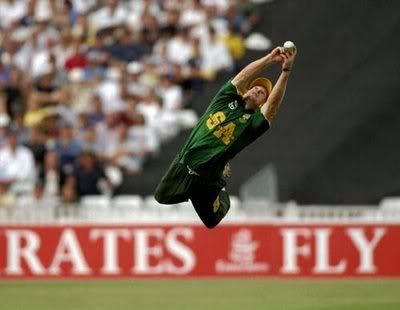
*Acknowledgements to Wikipedia.org and owners of pictures and videos used.
Sunday, December 28, 2008
4 wickets in 4 balls, a brilliant piece of bowling
Heres a video of the only time in international cricket that four wickets have been taken in 4 consecutive balls. The lucky bowler was Sri Lanka's fast bowler Lasith Malinga, who has a similar bowling action to that of Jeff Thompson, who is a legend in Australian cricketing circles. He took these wickets in a O.D.I against South Africa at the 2007 Cricket World Cup in the West Indies.
The four consecutive wickets were all taken in the same over and the unlucky batsmen to have been dismissed (and go down in cricketing history for a not so good reason) were as follows: Shaun Pollock, Andrew Hall, Jacques Kallis and Makhaya Ntini.
*Acknowledgements to Wikipedia.org and owners of pictures and videos used.
What is Twenty20 cricket?
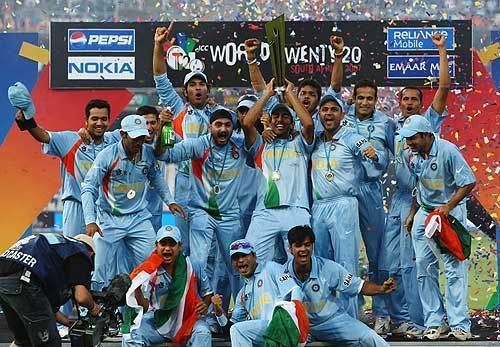
Twenty20 is a form of cricket, originally introduced in the United Kingdom for professional inter-county competition by the England and Wales Cricket Board (ECB), in 2003. A Twenty20 game involves two teams, each have a single innings, batting for a maximum of 20 overs.
A Twenty20 game is completed in about two and half hours, with each innings lasting around 75 minutes, thus bringing the game closer to the timespan of other popular team sports such as football. It was introduced to create a lively form of the game which would be attractive to spectators at the ground and viewers on television and as such it has been very successful. The ECB did not intend that Twenty20 would replace other forms of cricket and these have continued alongside it.
Since its inception the game has spread around the cricket world. On most international tours there is a Twenty20 match and most Test-playing nations have a domestic cup competition. The inaugural World Twenty20 was played in South Africa in 2007 with India defeating Pakistan in the final. The Indian Premier League is currently the largest and most popular (in terms of attendance and television audience) Twenty20 league in the world.
History:
Origins
The idea of a shortened format of the game was discussed by the England and Wales Cricket Board (ECB) in 1998 and 2001.
When the Benson & Hedges Cup ended in 2002, the ECB needed another one day competition to fill its place. The cricketing authorities were looking to boost the games popularity with the younger generation in response to dwindling crowds and reduced sponsorship. It was intended to deliver fast paced, exciting cricket accessible to thousands of fans who were put off by the longer versions of the game.
Twenty20 cricket was formally introduced in 2003 when the ECB launched the Twenty20 Cup and was marketed with the slogan “I don’t like cricket, I love it”.
Twenty20 Worldwide:
On 12 January 2005 Australia's first Twenty20 game was played at the WACA Ground between the Western Warriors and the Victorian Bushrangers. It drew a sellout crowd of 20,700.
Starting 11 July 2006 19 West Indies regional teams competed in what was named the Stanford 20/20 tournament. The event has been financially backed by billionaire Allen Stanford, who gave at least US$28,000,000 funding money. West Indies legends also backed the programme, and several "looked after" the teams during their stay in and around the purpose built ground in Antigua. It is intended that the tournament will be an annual event. Guyana won the inaugural event, defeating Trinidad and Tobago by 5 wickets. The top prize for the winning team was US$1,000,000, but other prizes were given throughout the tournament, such as play of the match (US$10,000) and man of the match (US$25,000).
On 1st of November 2008 the Superstars 101-0 West Indies team beat England 99 by 10 wickets. England slumped to 33-4 and then 65-8 after 15 overs before Samit Patel's 22 took them to 99 in 19.5 overs, still easily their lowest Twenty20 total. Chris Gayle got an amazing 65 runs not out.
On 5 January 2007 Queensland Bulls played the New South Wales Blues at The Gabba, Brisbane. A crowd of 11,000 was expected based on pre-match ticket sales. However, an unexpected 16,000 turned up on the day to buy tickets, causing disruption and confusion for surprised Gabba staff as they were forced to throw open gates and grant many fans free entry. Attendance reached 27,653.
For 1 February 2008's Twenty20 match between Australia and India, the Melbourne Cricket Ground was sold out based on pre-ticket sales and 84,041 people attended the match involving the Twenty20 World Champions against the ODI World Champions.
Twenty20 Internationals:
On 17 February 2005 Australia defeated New Zealand in the first men's full international Twenty20 match, played at Eden Park in Auckland. The game was played in a light-hearted manner - both sides turned out in kit similar to that worn in the 1980s, the New Zealand team's a direct copy of that worn by the Beige Brigade. Some of the players also sported moustaches/beards and hair styles popular in the 1980s taking part in a competition amongst themselves for best retro look, at the request of the Beige Brigade. Australia won the game comprehensively, and as the result became obvious towards the end of the NZ innings, the players and umpires took things less seriously - Glenn McGrath jokingly replayed the Trevor Chappell underarm incident from a 1981 ODI between the two sides, and Billy Bowden showed him a mock red card (red cards are not normally used in cricket) in response.
The first Twenty20 international in England was played between England and Australia at the Rose Bowl in Hampshire on the 13 June 2005, which England won by a record margin of 100 runs.
On 9 January 2006 Australia and South Africa met in the first international Twenty20 game in Australia. In a first, each player's nickname appeared on the back of his uniform, rather than his surname. The international match drew a crowd of 38,894 people at the The Gabba. Australia convincingly won the match with man of the match Damien Martyn scoring 96 runs.
On 16 February 2006 New Zealand defeated West Indies in a tie-breaking bowl-out 3-0; 126 runs were scored apiece in the game proper. The game was the last international match played by Chris Cairns - NZC handed out life-size cardboard masks of his face to patrons as they entered the ground.
Criticism:
Although the format has proved successful, it is not without its critics. Purists[who?] feel that Twenty20 waters down the sport and draws attention away from the more serious and technical arm of the sport, first-class cricket and Test Cricket.
It is also argued that since Twenty20 encourages far-from-technical cricket, youngsters wanting to pick up the game will be misguided into believing that cricket is all about trying to hit 6’s and 4’s no matter how you do it. Also it may create the misconception that cricket is a batsman’s game and there is little incentive learning how to bowl, since it is the bowlers that are usually at the receiving end, leading to fewer youngsters taking up bowling.
Rules of Twenty20 Cricket:
A Twenty20 game involves two teams, each have a single innings, batting for a maximum of 20 overs.
The Laws of cricket apply to Twenty20 with some exceptions:
-No more than five fielders can be on the leg side at any time.
-During the first six overs, a maximum of two fielders can be outside the 30-yard circle.
-After the first six overs, a maximum of five fielders can be outside the fielding circle.
Twenty20 Records:
Links to more information and records on Twenty20 Cricket:
*Acknowledgements to Wikipedia.org and owners of pictures and videos used.

In the International Spotlight...Denmark Cricket
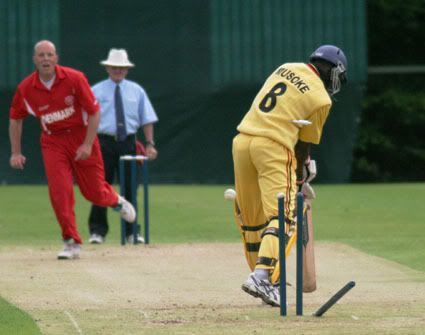
The Denmark national cricket team is the team that represents the country of Denmark in international cricket matches. They have been an associate member of the International Cricket Council since 1966 and are currently part of the ICC's High Performance Program.
History:
Beginnings
Cricket has been played in Denmark since the mid 19th century, with the first club being formed in 1865 by English railway engineers. The first organised match was played the following year between two teams of English players, with the first matches involving Danish players taking place in 1866. The game expanded greatly over the following twenty years, with 30 new clubs being formed in 1883.
Several touring sides from England and Scotland visited the country in the early part of the 20th century, including the famous Marylebone Cricket Club. In 1933, an attempt to organise the first international match against the Netherlands failed, and it wasn't until 1954 when the Danish national side played their first match against Oxford University, the year after the current Danish Cricket Federation was formed.
They then began to play against other national sides, primarily the Netherlands, who they first played in 1955. They played their first match against Scotland in 1961.
ICC Membership
Denmark became an associate member of the ICC in 1966, drawing their international against Scotland that year. They played Bermuda for the first time in 1969 and drew their first match against Ireland in 1970. They finally picked up their first international win against the Netherlands in 1972.
They played their first matches against Canada in 1974, losing a three-day match but winning the limited overs match. They played home internationals against East Africa and Sri Lanka, beating East Africa. They toured East Africa the following year, drawing with both East Africa and Kenya.
They took part in the first ICC Trophy in 1979, reaching the semi final where they lost to Sri Lanka. They did not take part in the 1982 tournament. In 1983, Ole Mortensen became the first Danish player to play county cricket. Denmark returned to the ICC Trophy in 1986 and finished third after beating Bermuda in the third place play off.
In 1989, Denmark hosted Australia for two one-day matches. They lost the first match in Brøndby by 45 runs and lost the second in Copenhagen by 54 runs. They fared better at home against Canada that year, winning twice against them. After playing both home and away against Bangladesh in 1990, they played in the ICC Trophy, reaching the second round.
Denmark again played in the ICC Trophy in 1994, finishing tenth in the tournament after losing to Namibia in the plate final. They played their first matches against France in 1995, and hosted the first European Cricket Championship in 1996, finishing third. They finished fifth in the following years ICC Trophy and were runners up in the European Championship in 1998.
In 1999, Denmark took part in the C & G Trophy for the first time. The following year, they took part in the ICC Emerging Nations Tournament in Zimbabwe, where they finished fourth, and the European Championship, where they finished last, without winning a game. The following year, they took part in the ICC Trophy in Canada, finishing eighth. The MCC toured Denmark in 2002, and Denmark won all three matches. They won just one match at that year's European Championship, finishing fifth ahead of Italy.
Present day
The Netherlands visited Denmark in 2003, winning both matches. Denmark played a two match series against Ireland later in the year, losing both matches and missing out on qualification for the ICC Intercontinental Cup. They again finished last in the European Championship the following year. In 2005, they played their final match in the C & G Trophy, losing heavily to Northamptonshire before taking part in the 2005 ICC Trophy, where they again finished eighth.
In 2006, Denmark again took part in the European Championship, finishing fourth after winning only against Italy. At the end of that year, it was announced that they would join the ICC's High Performance Program from 1 April 2007.
In August 2007, Denmark registered a win over Bermuda an ODI playing country, and towards the end of October 2007 they played in Kenya against domestic teams and Kenya A. Denmark led by Freddie Klokker who scored consecutive centuries in all their matches clean swept the Kenyan sides and Kenya A. Denmark bowled, batted and fielded exceptionally well.
Records:
ICC Trophy
Links to more information about Danish Cricket:
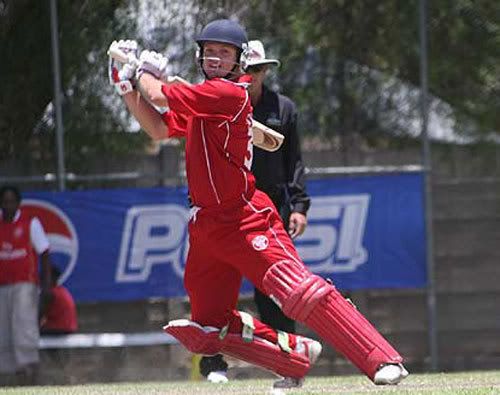
*Acknowledgements to Wikipedia.org and owners of pictures and videos used.

Saturday, December 27, 2008
Cricket Bat Care and Maintenance -Knocking in Your New Cricket Bat
Ideally you should knock in any new cricket bat for at least six hours, yes it's a lot but it will help condition your bat for heavy usage without damaging it.
You should also knock-in your new cricket bat even if it comes advertised as 'ready to play', as it still won't be ready for the full force of a hard new cricket ball, especially if you catch an edge or the ball hits the toe.
I've seen players go out on to the square with a brand new cricket bat, which hadn't been knocked in. In the first over he dug out a Yorker, which resulted in a 'fatal' crack in the toe of the bat. If it had been knocked in properly it's unlikely this would have ever happened. If you don't knock in your bat you could literally be 'throwing £200 down the pan'.
To knock in your bat I highly recommend you use an old high quality cricket ball.
Begin gently by tapping the bat, particularly focusing in on the edges, as these are a very vulnerable part of the bat and by the end you want the edges to be almost slightly rounded.
Spend 2-3 hours doing this stage of knocking in the bat, making sure you cover all of the face of the bat, excluding the splice area. Don't knock-in the back of the cricket bat.
After you have done this gradually increase the force with which you hit the bat, making sure you systematically cover all of the face of the bat. By the end you should be hitting the bat with full force to simulate the impact of a real cricket ball.
When you have finished knocking in the bat, you should first progress to using the bat for out field practice and then in the nets against an old used high quality cricket ball, especially avoid 'bat breaker' cricket balls, you know the ones, cheap, hard and usually shiny. If your bat is going to break or split it's these balls that'll do the damage.
Once you've played the bat in for a few hours in the nets it'll be ready to take out on to the square.
It's a tedious process but well worth the time and effort for the results you'll get for your hard work. Its worth mentioning that some sports shops may offer a knocking in service for a small fee. Personally I like to do it myself to see how the bat progresses as it becomes more knocked in.
For more cricket batting tips, cricket tips, news and gossip, head over to www.cricketsecrets.com and discover the #1 under used cricket secret, that you can use today to explode your cricket results!
*Acknowledgements to Ian Canaway.
Friday, December 26, 2008
Player Profile(#42)...Makhaya Ntini (South Africa)
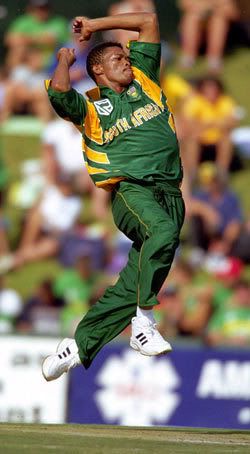
Makhaya Ntini (born 6 July 1977 in Eastern Cape Province) is a South African cricketer who was the first ethnically black player to play for the South African team. A fast bowler, he tends to bowl from wide of the crease with brisk, although not express, pace. He has survived legal controversy early on in his career to become only the third South African to take 300 Test wickets after Shaun Pollock and Allan Donald, and to reach second place in the ICC test match bowling ratings. He plays domestic cricket for the Chennai Super Kings in the Indian Premier League.
Background:
Ntini came from humble beginnings where he tended cattle in his home village of Mdingi in the Eastern Cape. It was there that his talent was discovered and he was sent to Dale College in King William's Town where he would develop his game. His action was intentionally modelled on West Indian great Malcolm Marshall.[citation needed] After a brief spell with Border his break came courtesy of an injury to Roger Telemachus and Ntini was included in the South African squad to tour Australia late in 1997. His international début came on January 16th at Perth against New Zealand where he took 2/30 off his full quota of 10 overs. A couple of months later, on March 19th, he made history by becoming the first black South African Test cricketer (though not the first non-White cricketer, as bi-racial Charles Llewellyn made his Test début in 1896). The Test match was at home in Cape Town against Sri Lanka and his maiden wicket was Aravinda De Silva who would be one of his 2 wickets in the game.
Controversy:
His career looked like coming to an end in 1999 when Ntini was charged and then convicted of rape. The case caused widespread controversy in South Africa with his conviction generating negative publicty in view of his status as the first black South African Test cricketer. Ntini maintained his innocence and was acquitted on appeal and looked to rebuild his international cricket career.
International career:
Ntini returned to the South African side for a Sharjah tournament in 2000. His improvement was clear as he bowled with greater control. In 2003 he became the first South African to take 10 wickets at Lord's Cricket Ground. Arguably his best performance, however, came on 12 April 2005, when Ntini took 13 wickets for 132 runs against the West Indies at Port of Spain. This remains the best bowling performance by a South African cricketer in a Test match. On 3 March 2006, Ntini also achieved the best bowling figures by a South African in an ODI, demolishing Australia with 6 wickets for 22 runs. Ntini is a popular figure in South African sport and he was voted their favourite sportsman in a research poll conducted by the South Africa Press Association.
From recent performances, Ntini has established himself as South Africa's premier fast bowler and one of the leading fast bowlers in the world. As of December 2007 he is ranked as the world's third-best Test bowler behind Muttiah Muralitharan and Stuart Clark, and ninth-best ODI bowler, according to the ICC rankings.
On 20 January 2007 Ntini dislodged Mohammed Sami to take his 300th test wicket, in his 74th test. On 1 August 2008 he removed England opener Alistair Cook to claim his 350th test wicket in his 90th test.
Links to more information on Makhaya Ntini:

*Acknowledgements to Wikipedia.org and owners of pictures and videos used.

Cricket Batting Tips - Foot Work
Recently I was asked, “is ‘foot work’ really that important?”
When batting in cricket it is essential to have excellent footwork. As good foot work is the basis for achieving excellence in cricket and is the foundation for good batting technique.
Foot work is absolutely necessary as all successful strokes start with effective footwork.
If you watch Brian Lara, Michael Vaughn, Ricky Ponting, Sachin Tendulkar, all of these amazing batsmen have outstanding footwork, often when these types of players don't perform it is simply due to lack of footwork.
Good footwork allows you to time the ball well and place the ball in gaps. It gets you in the optimum position to hit the ball, so you can hit it where you want and with ease.
If you have been struggling to play a particular shot for some reason it could be due to poor footwork causing bad timing and body positioning.
With faster bowlers it is even more essential to have excellent fast and precise footwork, so that you can get into a balanced position, in-line with the ball, so you can play the ball with control.
Getting quickly into position through footwork therefore is very important.
The more you practice your footwork against both fast and slow bowlers the easier you will gradually find it. Many players do what we call trigger movements just before the bowler releases the ball, this helps get the feet moving into position and into line much quicker and easier, especially against faster bowlers.
Next time you watch a game on TV watch the batsmen’s feet really closely as the bowler is about to deliver you’ll see these small ‘trigger movements’; small foot movements, which help the batsmen get in position and inline early.
As a batsman it is absolutely necessary to develop your foot work and foot movement, as all excellent strokes start with effective and efficient footwork.
To find out more tips on improving your footwork and stroke play feel free to visit www.cricketsecrets.com and start your run scoring spree!
*Acknowledgements to Ian Canaway.
Thursday, December 25, 2008
In the International Spotlight...Uganda Cricket
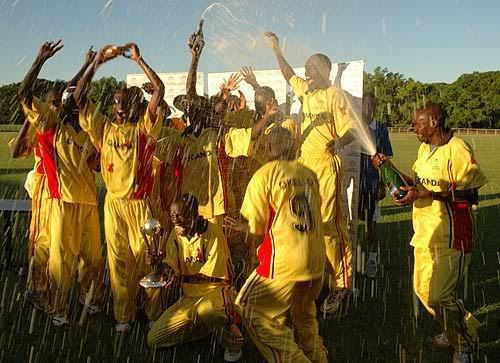
The Uganda national cricket team is the team that represents the country of Uganda in international cricket matches. Having previously been part of the combined East African and East and Central African teams, they became an associate member of the International Cricket Council in their own right in 1998. They began to play international cricket in 1951/52 when they first took part in a triangular tournament against regional rivals Kenya and Tanzania (then Tanganyika).
They have competed in the ICC Trophy on two occasions, in 2001 and 2005. They won Division Three of the World Cricket League in Darwin, Australia in 2007, qualifying them for Division Two of the same tournament towards the end of 2007, which also qualified them for a spot on the ICC's High Performance Program.
History:
East Africa team:
Uganda combined with their regional rivals Kenya and Tanzania to form the East Africa team. The first known match for this team was against a South African "Non-Europeans" team captained by Basil D'Oliveira in September 1958 in Nairobi, with the visitors winning by seven wickets. East Africa became an associate member of the ICC in 1966 and India toured the following year, winning a match against Uganda by 6 wickets before a first-class match against East Africa in Kampala which India won by 8 wickets.
East Africa toured England in 1972 and the Marylebone Cricket Club played a first-class match against East Africa in January 1974, winning by 237 runs. The following year, East Africa played in the 1975 Cricket World Cup in England. After various warm-up games, including a 3 wicket win against Glamorgan, they played New Zealand, India and England in the World Cup itself, losing all three matches. The World Cup was followed by a first-class match against Sri Lanka at the County Cricket Ground, Taunton, which the Sri Lankans won by 115 runs. East Africa played in the ICC Trophies of 1979, 1982 and 1986, without qualifying for the World Cup from any of them.
Uganda continued playing their regular matches against Kenya and Tanzania, despite Kenya leaving the East Africa combination in and the triangular tournament became a quadrangular tournament in 1966 when Zambia joined in. From then until the tournament's end in 1980, Uganda won the tournament just once.
East and Central Africa cricket team:
The East Africa team left the ICC in 1989 and was replaced by the East and Central Africa team the same year. This new team was a combination of Malawi, Tanzania, Uganda and Zambia, and they took part in the ICC Trophy for the first time in 1990, also taking part in 1994, 1997 and 2001.
Setting out on their own:
Uganda left the East and Central Africa combination and became an associate member of the ICC in their own right in 1998. Their first international tournament was the 2001 ICC Trophy. After winning all five of their first round games, they lost a play-off match against the UAE for the right to enter the second stage of the tournament. The following year, they finished third in their group in the Africa Cup.
In 2004, Uganda played their first first-class matches in the ICC Intercontinental Cup against Kenya and Namibia, winning against Namibia. In August that year, they finished second to Namibia in the Africa Cricket Association Championships in Zambia. This qualified them for the following years ICC Trophy, in which they finished in twelfth and last place after losing to Papua New Guinea in their final play-off match. Earlier in the year, they again played against Namibia and Kenya in the 2005 ICC Intercontinental Cup, losing both games.
Present Day:
In January 2007, Uganda faced Bermuda and Canada as those two teams prepared for Division One of the World Cricket League in Nairobi. This also served as preparation for Uganda's visit to Darwin, Australia, for Division Three of the same tournament. They won their games against the Cayman Islands, Hong Kong and Tanzania before beating Papua New Guinea in the semi-final. They then beat Argentina in the final of the tournament.
Uganda's performance in the Division Three tournament means that they have gained a spot in the ICC's High Performance Program, and will now travel to Windhoek, Namibia towards the end of 2007 where they will face Argentina, Denmark, Oman and the UAE in addition to hosts Namibia. A top four finish in this tournament will qualify them for the 2009 ICC World Cup Qualifier, whilst a bottom two finish will mean that they play in Division Three again in 2009.
Uganda took part in a four-team Twenty20 tournament prior to the 2007 Twenty20 World Cup, playing games against Pakistan, Kenya, and Bangladesh in Nairobi. As expected, they lost against Pakistan and Bangladesh, losing but they stunned African rivals Kenya with a two-wicket win.
Their next matches were two one-day games against Bermuda, also in Nairobi, in October 2007. They surprised their more experienced rivals, going down by just seven runs after Nandikishore Patel and Danniel Ruyange scored half-centuries, before winning the second match by 43 runs with Joel Olwenyi scoring a half-century of his own.
Links to more information on Uganda Cricket:
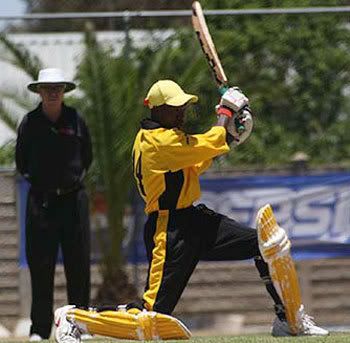
*Acknowledgements to Wikipedia.org and owners of pictures and videos used.

Cricket Batting Tips: The Sweep Shot And Reverse Sweep
The sweep and the reverse sweep are two batting shots which are not commonly used, especially the reverse sweep which is rarely used. However both shots can be used in certain batting situations and are an effective way to score runs and keep the score board ticking over.
There is a high element of risk with the sweep shot, so good judgement and excellent timing is essential. Avoid playing the sweep and reverse sweep early on in your innings especially to straight deliveries, as it is not a good idea to play it until you have your eye in and know how the pitch is playing and what the bowler is doing. As for example, if the ball stayed low it would be quite easy to misjudge and get out LBW or bowled which you definitely want to avoid, so be patient and play yourself in first.
The sweep and reverse sweep are both cross batted shots and should ideally be played to slow deliveries which are of a good length and not too full. To play the orthodox sweep shot, first wait for the ball to be released before making any movement – DON'T PREMEDITATE THE SHOT!
Once you have determined that the ball is there to play the sweep shot to, move your front foot as far down the wicket towards the pitch of the ball as you can. As you are moving forward bend both knees simultaneously so that you whole body is low down, let your back knee touch the ground to act as an extra base of support. Try to stay balanced and relaxed. Bring the bat down from the off side and across the ball towards the leg side and aim to hit it either in front of or behind square leg. You can roll your wrists over the ball as you hit to help keep it on the ground. Aim to have your arms fully extended when you contact the ball.
To play the reverse sweep, get in to the same position as for the orthodox sweep, however this time, bring you bat down and across from leg side towards the off side, so you are aiming to hit the ball through the gully area. This shot requires very good coordination and timing as you have to twist the bat round so that the bat face faces the off side at the point of contact without altering your grip.
Common problems:
-Premeditating the shot- deciding to play the shot before the bowler has bowled the ball. Wait until the ball is released from the bowlers hand before deciding to play the shot.
-Playing the sweep too early in the innings before getting your eye in. Wait until you are set and know how the pitch is playing and what the bowler is doing before attempting the shot.
-Trying to hit the ball too hard. Good timing and technique is better and more effective as you need to reduce the risk as much as possible.
-Playing the shot to deliveries which are either too full or too short, so good judgement of length is required.
Remember that the sweep and reverse sweep are quite hard shots to master and carry quite a lot of risk, so make sure that if you intend to use them, practice the shots in the nets and in training to get a feel for the shot and so you know when to play it; so that when you come to use them you are confident and skilled enough to do so.
To find out more on how to improve the sweep and reverse sweep shots, and many more cricket shots, head over to www.cricketsecrets.com today!
*Acknowledgements to Ian Canaway.
A very merry cricket christmas to all!
Hi everyone,
Just would like to wish all my readers a very merry cricket christmas and a happy cricket new year :). Make sure you take yourself and your family and friends to the park or even your back yard and have some fun playing a good game of backyard cricket, while enjoying each others company :). Feel free to add your comment about any backyard cricket games you have played on christmas day...

Wednesday, December 24, 2008
Tips for Buying a New Cricket Bat
When it comes to buying a new cricket bat there are a number of factors that you need to address before making your final decision to purchase a new cricket bat, such as:
- The brand,
- The size,
- The model,
- The weight,
…these are just a few factors to consider.
This article will look briefly at a few tips to follow when it comes to replacing your old favourite bat with a new cricket bat.
Choosing a cricket bat based on its brand really comes down to personally preference, as realistically there is not much major difference between brands. They all have cricket bats with similar attributes and features; it is the variation between models that I would pay closer attention too, not the brand name. However it is worth mentioning that some of the new Kookaburra cricket bat models are almost unique, as some are now reinforced with a new graphite matrix, giving “maximum power transfer and increased strength”.
When buying a new cricket bat, carefully select the model of cricket bat that most suitably fits your style of play. As some bats are designed specifically certain styles in mind, for example the Kookaburra Big Kahuna, is designed for strong, ‘big hitters’. Whereas the Kookaburra Kahuna Ricky Ponting cricket bat is an excellent choice for a stroke player who likes to hit boundaries.
It is very important when buying a new cricket bat to choose the correct size bat. As a bat that is too large or too small will only hinder your playing ability. I’ve found the best way to determine if a bat is of the right size, is to stand in your batting stance and rest the toe of the bat against the outside of your back foot, lean the cricket bat so that the top of the handle rests next to the inside groin of your front leg. If the bat is of the right size it should rest comfortably next to your box on the inside groin of your front leg.
The weight of a cricket bat is probably most important and you should choose a lighter bat where possible. A lot of players make the mistake of buying a bat which is too heavy and their performance suffers as a result, this is especially applicable to younger players who are often lulled into buying bats which are either to heavy or too big. As an adult I tend to choose a weight of around 2’ 8 – 2’ 10 oz, in a short handle (SH).
You should also take into account to grade and type of the willow of the cricket bat. Most bats are made from English Willow, which is a soft fibrous wood, with good striking qualities and is the best option. There is also Kashmir Willow, which is cheaper, harder and quite durable. It is often used in junior bats and produces less ball striking satisfaction. Always choose English Willow when given the option.
Cricket bat willow is graded on a scale from G1+ to G4. A willow grade of G1+ is the highest grade and is used by the top professionals, it is the best willow and is unbleached with straight even grains and no markings or discolouration. It’s more expensive but as always you get what you pay for!
Grade 4 (G4) willow is often non-oil and will usually have a covering on the face, such as an anti-scuff covering. It is the lowest grade of willow, which is represented in the price. If you have the money always opt for the highest grade willow you can afford.
You can now buy cricket bats online cheaper than you can offline, as online stores tend to have fewer costs associated with their businesses and so can offer cheaper prices and discounts. Also most offer guarantees on their bats so you can return it if the size or weight is not quite what you want. A sneaky tip; if you see a new bat you like go to your local store, check the size, weight, feel and pickup, then buy online, so you’ll get exactly what you want and save money in the process.
These are just a few ideas and tips I consider when buying a new cricket bat, most important are the bats size, weight and feel. Obviously the price is an important factor, but by buying online you can often save money.
Discover amazing cricket tips and tricks at www.cricketsecrets.com that you can use today to greatly improve your cricket results!
*Acknowledgements to Ian Canaway.
Player Profile(#41)...Jeetan Patel (New Zealand)
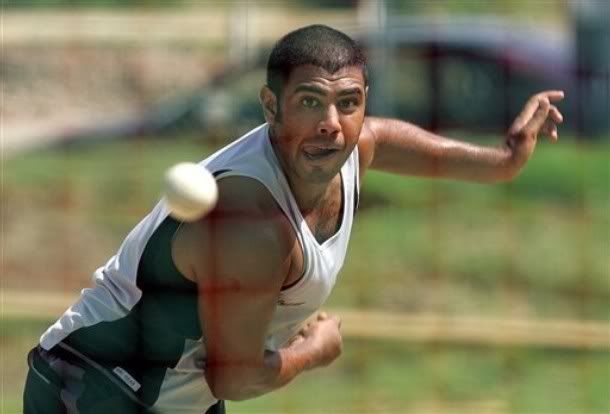
Jeetan Shashi Patel (born 7 May 1980 in Wellington) is a New Zealand cricketer of Indian origin. Patel is a right arm off spin bowler. He plays domestic cricket for the Wellington Firebirds and has represented the New Zealand Black Caps in One Day Internationals, Twenty20 matches, and a Test.
Patel was earmarked as a promising player early in his career. He played age group cricket in Wellington at under 15, under 17, and under 19 levels. He played for the New Zealand Cricket Academy in a one-day match against England A in 1999 and made his debut for Wellington in New Zealand's 1999-2000 domestic season. Patel currently has a first class bowling average of around 40 and a List A bowling average in the mid-30s.
Patel showed steady improvement as a bowler during the 2004-05 season, taking 26 first class wickets at an average of 32.84. He played two one-dayers against South Africa A on the 2004-05 New Zealand A tour of South Africa. He represented the North Island in the 2004-05 State of Origin match and played for the New Zealand Academy in the 2005 Cricket Australia Emerging Players Tournament.
In the 2004 English Season, he represented Buckingham Town Cricket Club, making a big impact in the 1st Team as well as progressing youngsters in local development schemes. Patel became the first player in twenty years to take 50 league wickets during his spell at the Bourton Road club and first player ever to go on to play international cricket.
Patel was a member of the 2005-06 New Zealand Black Caps tour of Zimbabwe. He made his ODI debut for New Zealand against Zimbabwe in the 2005-06 Videocon Tri-Series. He toured Sri Lanka with New Zealand A later in the season and played in the Triangular A Team Tournament at the conclusion of the tour.
Patel was selected for the one-day leg of New Zealand's 2005-06 tour of South Africa. He made his international Twenty20 debut on the tour and was named Man of the Match, returning bowling figures of 3 for 20 off 4 overs. He played as a Supersub in the first ODI against the Proteas, returning creditable bowling figures of 2 for 48 off 8. Other career highlights include a Man of the Match performance for New Zealand against Sri Lanka in the fourth ODI of Sri Lanka's 2005-06 tour of New Zealand. Playing as a Supersub in his fourth ODI, Patel restricted the run rate and built pressure at a crucial period during Sri Lanka's run chase, finishing with match figures of 2 for 23 off 10.
Patel made his Test debut against South Africa in the second Test of New Zealand's 2006 tour of South Africa.
New Zealand coach John Bracewell has described Patel as a "long term investment". He is the selectors' preferred second spinner in international matches, behind Daniel Vettori.
Patel is not related to former New Zealand spin bowler Dipak Patel.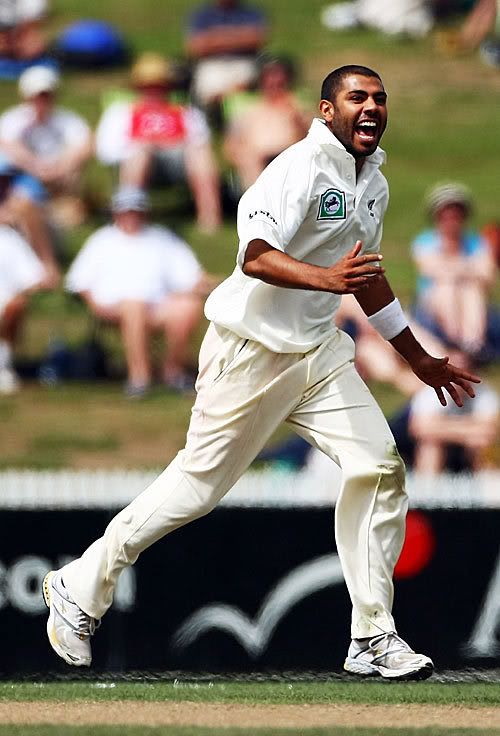
*Acknowledgements to Wikipedia.org and owners of pictures and videos used.
Cricket Fielding Tips: Improving Your Cricket Fielding
When fielding during cricket there are many things to think about and consider depending on where you are fielding. This brief article will look at a few essential cricket fielding tips which you can incorporate into your game to improve your fielding.
Where ever you are fielding you should always be on the balls of your feet so you can react and change direction quickly. If you are caught flat footed you’ll be slower off the mark and potentially give away more runs.
Try to anticipate where the ball will go; you can do this by carefully watching the batters shape and movements. This may be a little difficult at first but after a bit of practise will become second nature and you’ll react much quicker to any shots coming your way and field better as a result.
When you are fielding close to the boundary and have to throw from the deep, try to aim your throw just above the keepers head and the ball should drop nicely in to his gloves, provided you have a relatively strong throwing arm.
When catching close to the wicket, such as in the slips, gulley or short leg, make sure you stance is correct with your feet shoulder width apart or slightly wider. Spread your weight evenly across both feet, resting lightly on the balls of your feet, with your knees flexed. Keep your hands together, close to the ground with your fingers pointing down. Keep your head up with your eyes level and stay alert.
When catching the ball in close, watch the ball all the way into your hands, allowing the ball to come to you; don’t try to snatch at it. ‘Give’ with the ball as you catch, cushioning the impact. When catching in the deep, try and catch the ball at eye level and cushion the ball into your chest.
The ball can come to you at any time so it is really important you stay alert and awake so you can stop that vital run or take a match winning catch.
These are just a few cricket fielding tips that you can incorporate into you game; there are many more cricket fielding tips for specific aspects of fielding. However these are the general cricket fielding tips I’ve found to be the most useful when fielding myself.
Discover amazing fielding tips and tricks at www.cricketsecrets.com that you can use today to learn how you too could become a fielding superstar.
*Acknowledgements to Ian Canaway.
Thursday, December 18, 2008
Cricket Tips: Visualisation: The Key to Cricket Success?
An excellent cricket tip I picked up is the power of visualisation. It is a skill which is often neglected by cricketers. For batsmen, bowlers and fielders at any level of the game it is an important skill that should be mastered.
Visualisation or guided imagery is a very powerful technique that can help increase both your efficiency and effectiveness in achieving your cricket goals, whether it would be scoring one hundred runs, playing a perfect cover drive or taking that vital wicket or catch.
“You must see your goals clearly and specifically before you can set out for them. Hold them in your mind until they become second nature.” --Les Brown--
All top class athletes utilise visualisation to mentally rehearse what they have to do and how they are going to achieve it. By doing this they train their minds and bodies to actually perform the skill as effectively and efficiently as possible.
For example, before batting Ricky Ponting will have visualised every stroke and shot in his many inning’s this season which have netted him an average of over one hundred so far this season.
When you begin to use visualisation techniques, you want to mentally create a vivid scene in you mind of your wanted outcome. You want this scene to be as detailed and clear as possible, you need to be able to see, feel and smell your success.
Actually visualise your success, picture yourself taking that critical wicket or scoring that winning run. Visualise whatever you want your desired situation to be, how it feels, what your emotions are, imagine being in the situation and succeeding.
Make visualisation a daily activity, to go alongside your other cricket training. By succeeding in your mind you will become more passionate about your cricket and you will work harder, pushing yourself to do whatever is necessary to achieve success.
When using visualisation never ever consider failure or giving up as this will likely be the eventual outcome. Always have a positive mental attitude and draw on your success as inspiration however small they may be.
"We are what we repeatedly do. Excellence, then, is not an act, but a habit." -- Aristotle –
Dream big and aspire to succeed at the highest levels, be patient, work hard and persevere there is nothing except yourself stopping you from achieving your goals in cricket.
For more cricket batting tips, cricket tips, news and gossip, head over to www.cricketsecrets.com or visit our new forum and share your tips and advice with other cricketers!
*Acknowledgements to Ian Canaway.
Cricket Tips: Goal Setting for a Successful Cricket Season
One of the essential cricket tips I ever learned was that of goal setting. The ability to set goals and effectively motivate yourself to achieve them are two essential cricket tips and skills that will help you achieve success in any cricket season or sport.
Starting a cricket season without goals could be compared to batting blindfolded in the dark. What would be your chance of hitting the ball? It is essential to set goals at the start of the season to aim for: How many runs, wickets or catches will you takes? Giving yourself a target to aim for will help focus your mind and mentally prepare you for setting plans to achieve them.
If when you start your cricket season, you have no goals and aim at nothing; is it not unlikely that you will hit nothing and achieve nothing? If you haven’t set goals, start now and set yourself the goal to score 250 runs or take 60 wickets by the end of the season, then plan how you will do it.
To set effective goals there are a few things you need to know about yourself which will affect how you set your goals. You are affected by, the environment in which you live, your experience and knowledge, your attitude and dreams and visions for the future.
When you set your goals you need to decide what you want and when you want to achieve each goal. You should spend time writing down your goals and display them in a prominent position where you will see them daily to remind yourself to stay motivated and focused. Cross off your goals once they’ve been achieved, add new ones to ensure when you reach your goals, you can further them and take your cricket to the next level.
“Don’t set your Goals to low. If you don’t need much, you won’t become much”. - - Jim Rohn - -
I’m sure you will have come across the SMART analogy, with regards to goal setting. It contains the most important concepts to consider and adhere to when setting your goals.
Goals should be; Specific, Measurable, Achievable, Realistic and Time related.
For example it would be unwise to set a goal of scoring one hundred runs every week, it’s just not a realistic goal for the average person, unless you are Michael Vaughn or Ricky Ponting that is! As you would probably fail to reach this goal, your motivation would suffer and you might start doubting your cricketing ability.
Before you start setting your goals write a list of all the things you want to achieve; whether it would be your first one hundred runs, fifty wickets in the season or first catch. By doing this it will help focus your mind and motivate yourself to succeed.
Now set your goals, they need to be SMART and you need to set both short term and long term goals, and also daily goals, for specific match days. All successful cricketers set goals and prioritise them in order of importance.
By making goal setting a habit there is no reason why you cannot achieve your cricketing goals.
For more cricket batting tips, cricket tips, news and gossip, head over to www.cricketsecrets.com and discover the #1 under used cricket secret, that you can use today to explode your cricket results!
*Acknowledgements to Ian Canaway.
Wednesday, December 17, 2008
Player Profile(#40)...Chris Gayle(West Indies)
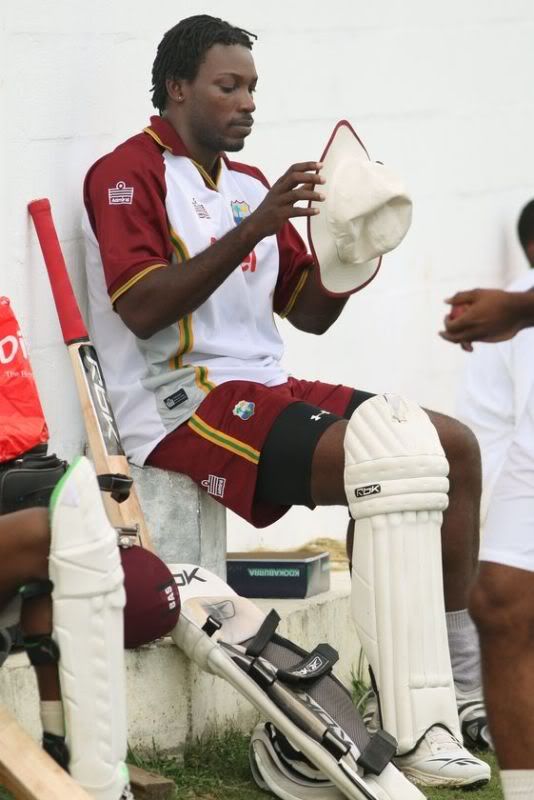
Christopher "Chris" Henry Gayle (born 21 September, 1979 in Kingston, Jamaica) is a West Indian cricketer who plays international cricket for the West Indies and domestic cricket for Jamaica. He is a hard-hitting left-handed opening batsman who can bowl right-arm off spin when called upon. Gayle has a variety of quality shots that he can perform.
Gayle played for the West Indies at youth international level after he made his first-class debut aged 19 for Jamaica. He played his first One Day International 11 months later, and his first Test match 6 months after that.
Gayle, who normally opens the innings when he plays for the West Indies, is a destructive batsman who is most effective playing square of the wicket. In July 2001, Gayle (175), together with Daren Ganga (89) established the record for opening partnerships at Queens Sports Club, Bulawayo when they put on 214 together against Zimbabwe.
However, generally speaking he had a slow start to his international career, but invigorated it in 2002, ending the year with three centuries against India in November and becoming the fourth West Indian to score 1,000 runs in a calendar year. Along with Vivian Richards, Sanath Jayasuriya and Brian Lara he is the only player in One Day International history to have three or more scores of 150.
In 2005, Gayle was dropped for the first Test against South Africa along with six other players following a dispute over sponsorship issues (see below). He returned for the second test but had a poor series until the fourth Test, where he made his career-best: a match-saving 317. It was the first ever triple century against South Africa and up until Mahela Jayawardene made 374, it was the highest individual Test score against them.
In August 2005, Gayle joined Worcestershire for the rest of the English season, playing eight matches. He made two half-centuries in three first class matches and two half-centuries in five one-day matches, and won one Man of the Match award in the one-day National League. However, Worcestershire were relegated after Gayle made 1 in the final match against Lancashire.
Gayle was named Player of the 2006 Champions Trophy, where the West Indies nearly defended the title which they won in 2004, being defeated in the final by Australia. Gayle scored three centuries and totaled 474 runs, 150 more than any other batsman, and also took eight wickets in as many matches.
Gayle, in keeping with the rest of the West Indies team, had a poor World Cup in 2007. He recorded a series of low scores; the one exception being a blistering 79 off 58 balls against England in the West Indies' final match.
Gayle currently holds the record for the highest innings in a Twenty20 International, having scored 117 against South Africa in the World Twenty20 Championship, and, to date, is the only batsman to have hit a century in the Twenty20 format.. and he hit Ten sixes on the match... format. He is currently the only cricketer to have hit centuries in all three formats of international cricket.
In April 2008, Gayle was auctioned by the franchise Kolkata Knight Riders of the Indian Premier League, but missed the opening games due to an ongoing Sri Lanka tour to the Caribbean. When he finally joined the team, he missed out on the action due to a groin injury he picked up during that tour. Afterwards, he had to leave to join the West Indies team for a home series against Australia, thereby not playing in the inaugural version of the IPL at all.
Controversies:
Gayle is generally regarded as a calm and cool cricketer, but he has been involved in a few controversies.[citation needed] In 2005 Gayle was involved in the dispute between the West Indies Cricket Board and a number of players over sponsorship issues. These players had personal sponsorship deals with Cable and Wireless, who used to sponsor West Indian cricket. However, since the West Indies had recently become sponsored by Cable and Wireless' rivals Digicel the West Indies Cricket Board demanded the players dropped their Cable and Wireless deals. When the players refused to back down, the West Indies Cricket Board dropped them for the first Test against South Africa. Gayle later cut his deal with Cable and Wireless and rejoined the side for the second Test. In March 2006, he was charged with conduct contrary to the spirit of cricket during a Test against New Zealand but was subsequently found not guilty. Later that year, during October's Champions Trophy tournament in India, he was fined 30 percent of his match fee after repeated verbal exchanges with the Australian batsman Michael Clarke. He also publicly criticised the West Indies Cricket Board during the 2007 tour of England which led to an official reprimand and warning.
Links to more information on Chris Gayle:
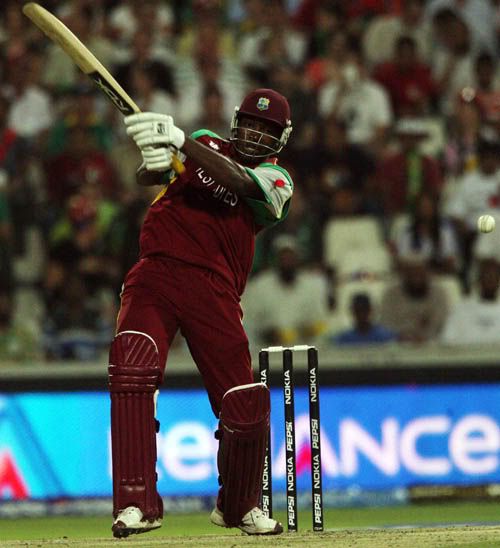
*Acknowledgements to Wikipedia.org and owners of pictures and videos used.

Monday, December 15, 2008
Introducing...The ICC Intercontinental Cup

The ICC Intercontinental Cup is a cricket tournament organised by the International Cricket Council as part of its cricket development program. It is designed to allow Associate Members of the ICC the chance to play first-class cricket matches against teams of similar skill in a competition environment and prepare them for eventual promotion to Test cricket status.
Tournament history:
2004: The inaugural ICC Intercontinental Cup was completed on 22 November 2004 when Scotland won the title in Sharjah, United Arab Emirates. Scotland beat Canada by an innings and 84 runs in the final. The competition included 12 teams, divided by geographical region into four groups of three. Each team played the other two teams in its group once each. The top team in each group then progresses to the semi-finals, and the winners of those to the final. In order to encourage competitive play and avoid deadlocks, a point system including bonus points was used.
2005: The tournament was played for the second time in 2005. The teams and groupings were the same, except that Hong Kong came in to replace Malaysia, and the Cayman Islands replaced the United States who were expelled from the competition by the ICC because of then ongoing political problems within cricket in the US.
The points system was also modified so that teams could score unlimited batting points in the first innings and a maximum of 4 points in the second innings.
The tournament was won by Ireland who defeated Kenya in the final.
2006-07: The tournament was cut from 12 to eight teams, with Hong Kong, the Cayman Islands and Uganda losing the right to participate, while Namibia knocked out Nepal in a play off for the eighth place. The match length was extended from three to four days, and each team was scheduled to play at least three matches. The teams were divided into two groups of four, with each team playing the other once and the top two teams qualifying for the final, and the points system has also been changed: 14 points are now awarded for a win, and six for a first-innings lead. Due to preparations for the 2007 World Cup and the longer tournament, the final was played in May 2007, where Ireland defeated Canada to defend their title.
2007–08: The 2007–08 tournament was played as a single round robin league of eight teams, so that each team played seven matches. The teams ranked first and second at the end of the pool stage contested the final.
Namibia finished on top at the pool stage, but lost the final against second placed Ireland in late October in Port Elizabeth, South Africa. Ireland thus completed a hat-trick of Intercontinental Cup victories, having been undefeated in the competition, and having won three consecutive make-or-break away fixtures in Africa (against Namibia, Kenya and Namibia again) to clinch the title.
Countries that are or have participated in the ICC Intercontinental Cup:
Links to more information on the ICC Intercontinental Cup:
*Acknowledgements to Wikipedia.org and owners of pictures and videos used.

In the International Spotlight...Estonia Cricket
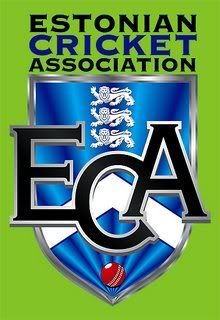
The Estonian Cricket Team is a fledgling team which represents the nation of Estonia in International Cricket competitions. Granted Affiliate Status in June 2008. Estonian cricket relies upon the support of touring sides from Britain and other European nations to get matches to play. In the 2007 season they won over 80% of all their games.
The president of the Estonian Cricket Association is Barry Jason, who currently holds the world record for the most amount of countries played in by one person, 128 in total. Estonians who have recently made the grade as International players include Andres Burget, Gleb Bihanov, Andrus Kämbre, Kristjan Kogerman, and Risto Koovit.
The most famous tourists to Estonia have been Sir Tim Rice, and his team the Heartaches, the MCC, the Lord's Taverners and most recently Carmel & District Cricket Club captained by Timothy Abraham.
Estonia is also home to a unique variant of the game in Ice Cricket. The Ice Cricket World Championship is held annually in the Estonian city of Tallinn and is played upon the surface of a frozen lake. These tournaments are now sponsored by Bulmers Original Cider, Scottish & Newcastle, and they last from January until late March.
The year 2007 saw the formation of the Estonian cricket league. The league consists of four Tallinn based teams who compete in a round robin format. Players who are members of the Estonian Cricket League are eligible to be selected for the National side. 2007 saw a victory for Kalev CC captained by Andres Burget.
Links to more information on cricket in Estonia:
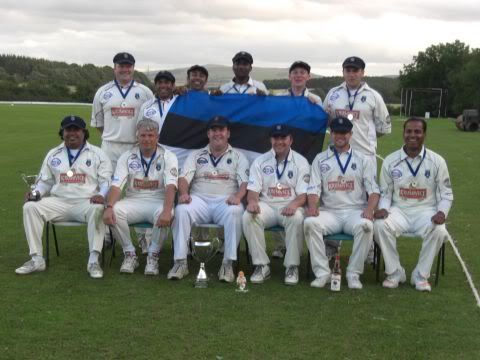
*Acknowledgements to Wikipedia.org and owners of pictures and videos used.

Sunday, December 14, 2008
Player Profile(#39)...Sohail Tanvir (Pakistan)
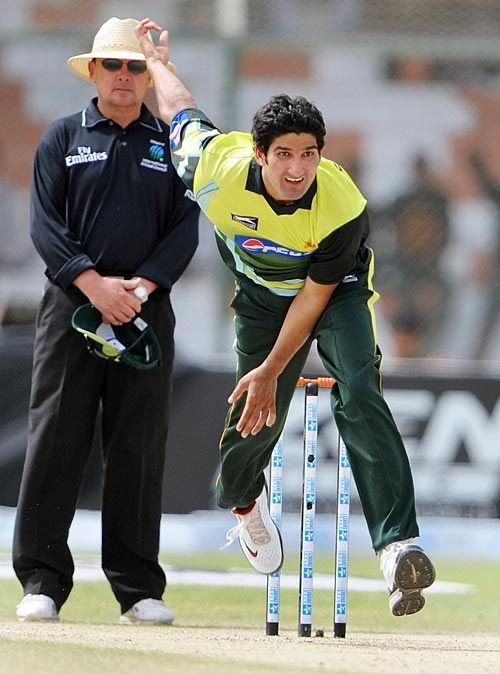
Sohail Tanvir (born December 12, 1984 in Rawalpindi, Punjab) is a Pakistani cricketer. He created a name for himself in his early years as a street cricketer of Rawalpindi, and was known as "Sohail Kukree".[citation needed]
Domestic career:
IPL career:
On March 11, 2008, Tanvir was signed up in the second round of the Indian Premier League's players' auction by the Jaipur franchise, Rajasthan Royals, for $100,000.
Playing in his third match of tournament, on May 4, Tanvir took a match-winning six wickets against the Chennai Super Kings at the Sawai Mansingh Stadium, Jaipur. His figures of 4-0-14-6 are a record for Twenty20 cricket. He ended the tournament as the highest wicket-taker, with 22 wickets from 11 matches at an average of 12.09, an economy rate of 6.46 and a strike rate of 11.20, the best among bowlers with more than six wickets.
In the final of tournament, on June 1 at the Dr DY Patil Sports Academy in Mumbai, with Rajasthan chasing 164 to win, Tanvir added 21 runs along with captain Shane Warne. He hit the winning runs of the final ball of the innings, to see the Royals home. He was later presented with the "Purple Cap", an award for the leading wicket-taker of the tournament.
A statistical analysis conducted by Cricinfo after the conclusion of the league stage of the tournament rated Tanvir as the most successful player. He was also rated as the second best value player of the tournament, having been signed on for $100,000.
International career:
An allrounder, he is a hard-hitting left-handed batsman and left-arm fast-medium bowler who also bowls occasional left-arm orthodox spin. Despite not having taken a single wicket during his ten Twenty20 matches domestically, he was selected for Pakistan's squad for the inaugral World Twenty20 after Shoaib Akhtar was sent home. He made his Twenty20 debut in the tournament, and took six wickets in six matches, with best bowling figures of 3 for 31 in four overs against Australia. Though considered an allrounder, Tanvir did not get a chance to bat in the tournament until the final, where he made his first international runs, with a six off his first ball, aiding Pakistan back into the game.
After impressing in the ICC World Twenty20, he was selected to play in the ODI series against South Africa in October, 2007. He was then selected for the tour of India, and took eight wickets in the ODI series. He also took part in the Test series that followed, making his debut in place of the injured Umar Gul. On debut at the Feroz Shah Kotla in Dehli, he took three wickets which included Sourav Ganguly and Rahul Dravid. In Asia Cricket Cup, June 2008, Pakistan played their first game against Hong Kong at Karachi. In that match, Pakistan's top order was badly ripped by Hong Kong bowlers before Sohail Tanvir set up a 100 run stand along with Fawad Alam for the 8th wicket. Sohail scored his maiden ODI 50 in that match. He scored 59 off just 55 balls which took Pakistan to a respectable score of 288. After that, in the match vs. Sri Lanka, Tanvir took his first 5 wickets haul. He ended at 5/48 in 10 overs.
Links to more information on Sohail Tanvir:
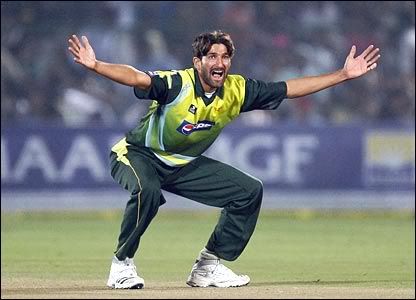
*Acknowledgements to Wikipedia.org and owners of pictures and videos used.















